Return to The Definitive RCT Reference Guide homepage
Under the "Build New Ride/Attraction" icon ![]() you will find 6 categories of facilities:
you will find 6 categories of facilities:
Rides (excluding Shops & Stalls) are the main reason Guests come to the park, and variety is the keyword in building rides {m}. Some rides have variants (different vehicles and/or operation modes). The maximum number of rides (including Shops & Stalls) that a park can contain is 255. Each ride also has its own limits as to how high above the land surface and how low beneath the land surface they can be built.
The game prefers that you mentally visualize the park as being divided into approximately three to seven segments, and then place at least one Food, Drink, and Bathroom stall into each. Besides being an efficient layout for servicing your guests "needs", it helps in earning Awards. There is no game requirement, but it can be visually interesting if you theme (and demarcate with name banners) these segments differently.
Ticket prices affect the popularity of a ride and, therefore, the attitudes of your guests {m}. Ride profitability can be easily viewed in the Rides Info window. Bear in mind that Guests carry only a limited amount of money. If your Park Entrance Fee gets too close to the lowest average amount brought in by guests, they either won't enter your park, or will enter and complain that everything costs too much {s}. At a satisfaction rating of 50% or less, the guests start exhibiting price resistance. If guests complain that a ride is not a good value or that they can't afford to go on it (or won't pay that much), consider lowering the price of admission {m}. If there are plenty of riders but you are still not making a profit, consider raising the admission price {m} ($100 is the maximum you can charge for the Park Entrance Fee). A Ride Satisfaction Rating somewhere around 70%, is a good compromise between ride profits and guests percieved value.
Park Entrance Fees and Attraction Ticket Prices affect each other. If the Park Entrance Fee is high, guests will decide to enter based on the Park Rating {m} (so when first starting a park, you will probably have to keep the Entrance Fee low {s}). If an Entrance Fee is high, the guest then expects low (or non-existant) Attraction Ticket Prices {m}. Conversly, if there is is no Park Entrance Fee, they're willing to pay premium Attraction Ticket Prices {m}. It is a good idea therefore when initially starting a park, to set the Park Entrance Fee at $10 {s}. This is because even if your park features just a barren field, an occational Guest will pay this amount just to walk through the gates {s}. [NOTE: In some Scenarios (such as ALL the Loopy Landscapes scenarios) it is not possible to charge an admission price.] Few Guests will think twice about paying $10 to enter a medium sized park (and then still go on to pay perhaps an additional $35 on rides and food), and on average, Guests tend not to complain too much about paying even $15 to $20 {s}. If the guests comment that the Park Entrance Fee is low, you should imediately raise the price by $10 {s}. Typically, you can raise the Park Entrance Fee by $5 for every FIVE Gentle or Thrill Rides you add to the park (by $10 for each Roller Coaster) {s}. Once you have secured $30,000, there is little need to further increase prices (and you may even want to drop prices to increase attendence) {s}.
Newly built and opened rides will attract more guests than one that has been running and available for a couple of years (so open new rides every now and then to prevent you park from becoming "stale") {m}. Note that a game "year" is measured as one park season - that's the eight months from March through October. Altering the colors, or changing the cars, can help to increase interest in an older ride {s}. Lowing the admission price as a ride ages will help for a time to keep patronage up (lower prices are more satisfying) {m}. If the admission price is very low, but patronage is still low, consider a Marketing Campaign to temporarily increase patronage {m}. Be aware that eventually it may make sense to dismantle an aging attraction that guests have lost interest in visiting and/or starts breaking down too much {m}.
All rides have an Excitement, Intensity, and Nausea statistic which affects guests. The ranges are broadly classified as:
Low (0.0 - 2.5), Medium (2.6 - 5.0), High (5.1 - 7.6), Very High (7.7 - 10.1), Extreme (10.2 - 12.7), and Ultra-Extreme (12.8 +).
The higher the Excitement of a ride, the more you can successfully charge for admission to the ride, and the more popular the ride will be with your guests {m}. The overall speed of the ride, its pacing, the look of it from the outside, nearby Scenery, the view from the ride, and the nearness of external objects (including footpaths and other rides); all affect Excitement {m}. Novelty (ride age) also affects Excitement {m} (newer rides have more Novelty value).
Here is a summary of using paths to increase a coaster's Excitement rating.
Here is a summary of what makes an Exciting Flat Ride.
Note: The Official RCT Strategy Guide hints when discussing the River Rapids ride that peeps require time to gain the Excitement benefit of viewing nearby scenery objects (it suggests that peeps moving over 10mph are traveling too fast to gain any Excitement boosting benefit from passing a scenery object).
A rides Intensity depends on all the forces, accelerations, changes of directon, inversions, and speed experienced by a rider over the course of the track {m}. Increasing Intensity on a ride will often increase Excitement (but watch out for an increase in Nausea as well). If Intensity becomes Extreme however, Excitement will drop to Low due to guests becoming banged and bruised. Try to keep vertical g-forces between +4.0 and -3.0 (although riders can tolerate an occasional brief higher burst) {s}. Intensity appeals to some guests, but not all of them {m}, so intersperse some wimpy rides with your intense rides. Cluster a few Gentle Rides near the front entrance, then evenly space them throughout the remainder of the park {s}. Place a few Thrill Rides between your Gentle Rides and your Coasters {s}. Guests will become frustrated if they have to walk a long distance to find a ride that meets their Intensity preference. Guests also need an opportunity to 'build-up' to the more Intense rides {s}. Roller Coasters draw the majority of your guests to your park, and bring in the most money; so place them at the back of the park so Guests must walk past everything in the front of your park to get to that Coaster they came to ride {s}.
Nausea has a strong influence on how your guests feel (physically) during and after the ride, and also on whether or not they'll choose to ride it in the first place {m}. Spinning rides tend to have high nausea ratings, and the more turns (especially sharp ones) and inversions you include, the worse it gets {m}. Try to keep lateral g-forces under +2.5 (preferably under +2.0) {s}. A Nausea Rating of 6.05 will make all but the most stable of stomachs give up thier contents {s}. Place Benches, Bathroom, and Trashcans near the exit of Thrill Rides, for the convenience of riders with weaker constitutions {s}.
Here is a discussion about interpreting E-I-N numbers for tracked rides.
Factors influencing Excitement include: speed of ride, pacing, look of ride from inside and outside, nearness of external objects to riders, surprises for the riders, and variety {s}. Many guests prefer High Excitement {s}.
Factors influencing Intensidy include: vertical g-forces, acceleration, changes in direction, inversions, speed, changes in elevation, perception of danger {s}. Many guests prefer High (to Very High) Intensity {s}.
Factors influencing Nausea include: spinning, sharp turns, high lateral g-forces, many inversions, excessive side-to-side movement {s}. Many guests prefer Low (to Medium) Nausea {s}.
Stations can be styled as: Plain; Canvas Tent; Wooden; Castle (brown); Castle (grey); Log Cabin; Jungle; Classical/Roman; Abstract; Snow/Ice; Pagoda; Space. Styling does not affect ride statistics, nor does it appear to affect a guests decision to use the ride during rain. You are never charged for adding Entrance and Exit buildings {m}. On rides that don't need a station platform or loading area (such as the "Haunted House"), place the Entrance and Exit off to the side so that Guests on the footpath can see as much of the ride's facade as possible {s}.
In multi-station rides (maximum possible number of stations is four), the maximum length of a train and number of cars is determined by the length of the shortest station. Although the maximum possible station length is 12, do not build long stations if you do not need the capacity (vehicles travel very slowly through stations). Although you must have both an Entrance and Exit at all stations on a multistation ride (and a mechanic must be able to access ALL these stations), these rides can still be made mostly or wholly one-way by either reducing the queue length for, or totally eliminating access to, a middle/end station ENTRANCE (you still need to provide for exiting passengers however).
When synchronizing stations, the only important consideration is that the 'stoplights' be adjacent to each other. There is no reason you have to have equal station lengths, and with more than two synchronized stations it becomes impossible.
In order to switch from a rising track to a dropping track, you must have at least one piece of level-transition track in the middle {m}. There is a limit to how high above the land you can safely raise track using supports {m}. You cannot build track underground unless you prepare the land for it {m}. You cannot have the track cross itself at the same level {m}. Track can be run under or over existing track, provided there is enough vertical clearance for the cars to pass through {m}.
It is important to keep ride duration under 6 minutes or guests will start complaining about wanting to get off the ride (timer starts from the moment a guest leaves the Entrance portal, so waits in a vehicle before getting a "green light" to leave the station adds to total ride duration). Even if the ride has a full load, the cars will not leave the station until the "Minimum Wait" time has elapsed {m}. Also, its a good idea to have an empty station when a returning train arrives, just in case the returning trains brakes fail {s}. To keep traffic moving through a ride; experiment with setting the ride to "wait for any load", and the minimum wait time according to the formula:
Min Wait Time = Ride duration / (Vehicles on Ride - 1)
Time is actually calculated quite strangely in RCT, as this study of RCT time reveals. For example, game time is too fast when compared to a coaster train's reported miles per hour.
If you remove a piece of construction (natural objects such as trees are not "construction"), you will recover some of the items original construction costs. More recent construction will give a higher return than older construction - and a ride that was never "opened" will often get a full refund for the cost of building {m}.
Your guests will flock to Water Rides during the summer months {s}. Milder Water Rides also provide an opportunity to showcase exciting parts of your park {s}.
As a ride ages, the Profit usually goes down (due to older rides having less Novelty appeal), Reliability decreases (due to the older equipment experiencing more mechanical breakdowns), and Down Time goes up (due to the quantity of breakdowns). Marketing, pricing, and refurbishment can boost profitability, while decreasing the time between ride inspections and limiting a Mechanics patrol area to the Exit of a single ride will reduce Down Time. Rides with Down Time exceeding 25% are candidates for replacement {s}. Note that if you demolish a ride, guests will loose any on-ride photos from that ride that they may be carrying.
Covered rides are popular when its raining {m}. Any "tracked" ride built with at least 40% of its track underground is considered a "covered ride".
The following rides are by nature automatically considered "covered" (and good choices for Scenarios with rainy weather):
Crashes are bad. Crashes will happen when either a car/train leaves its ride track and hits a surface, or two cars/trains bump into each other at a high enough speed (thus certain ride types are immune). The result is an "explosion", which will "kill" any guests involved (note that it is possible that there were no guests on the car/train involved). The ride will close automatically, and any guest in the queue will leave. As a notice to the player, an explosion sound will be heard, and the game view will immediately shift to the site of the crash (where fire and smoke will be seen).
A crash causes the ride to be saddled with a Crash History that lasts for 4 months. If the crash caused no injuries, the ride will nonetheless still experience a massive drop in Popularity for the duration of the Crash History. Afterwards guests will forget about the accident, and popularity will return to its previous level. If the ride had fatalities, for the duration of the Crash History most guests will refuse to ride the unsafe ride. Also the Parks Rating will experience an immediate severe decrease, resulting in far more guests than normal leaving the park, and fewer guests entering.
Crashes can be caused by poor ride design, and/or by breakdowns (especially Station Brakes Failure). Assigning a Mechanic to inspect the ride every 10 minutes (he needs to have access from a footpath to the ride Exit building and station platform) will keep breakdown possibility at a minimum. Bumping cars/trains will only crash when the combined impact speed exceeds 30mph. Adding extra braking into the track design (including possibly a
Cars/trains will only leave the end of an open tail track if the vehicle speed exceeds the gravity/friction retardation being exerted by the track on the vehicle to stop its progress (so be vigilant about not setting Powered Launch speeds too high). Vehicles not "locked" (unattached) to the track are especially vulnerable to leaving the track on curves and vertical curves (start of drop and crest of hill), when exceeding the speeds of:
Included with the original game and corkscrew follies are a number of pre-built example rides:
Bobsled RC = Big Bob, Mini Bob.
Car Ride = Mini Cars.
Go Karts = Figure 8 Track, Mega Track.
Hedge Maze = Mini Maze, Spiral Maze.
Inverted RC = Danglefeet.
Log Flume = Logger's Revenge.
Mine Train RC = Manic Miner.
Reverse Whoa Belly RC = Force 9.
River Rapids = Ropey Rapids.
Steel Corkscrew RC = Boomerang, Corkscrew.
Steel Mini RC = Crazy Caterpillar, Raging Rocket.
Steel RC = Exterminator, Fizzly, Shuttle Loop.
Single-Rail RC = Steeplechase.
Stand-Up Steel RC = Red Baron, Venom Rail.
Suspended RC = Flight of the Phoenix.
Suspended Single-Rail RC = Batflyer.
Vertical RC = Big 90.
Wooden Crazy Rodent RC = Crazy Vole, Mini Miner. Caution: Crazy Vole is subject to crashing
Wooden RC = Mischief, Woodchip.
Water Slide = Demon Drop.
Cycle Monorail = Cycle Monorail 1.
Flying RC = Flying Coaster 1, Flying Coaster 2.
Heartline Twister RC = Heartline Twister 1.
Steel Twister RC = Steel Twister 1.
Steel Wild Mouse RC = Steel Mouse 1, Steel Mouse 2.
Side-Friction RC = Side Friction 1, Side Friction 2.
Virginia Reel RC = Virginia Reel 1, Virginia Reel 2, Virginia Reel 3.
Wooden Reverser RC = Reverser Coaster 1.
Wooden Twister RC = Wood Twister 1, Wood Twister 2.
Chris Sawyer did not offer track examples for every tracked ride in the Original and Corkscrew Follies games, nor did he offer any track examples in Loopy Landscapes. Track examples are an excellent reference for a person attempting to build a ride type for the first time, so I offer these simple compact pre-built tracks to fill the missing example gap:
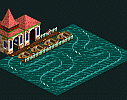 Boat Hire =
Boat Hire = ![]() Cracker Jack.
Cracker Jack.
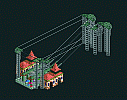 Chairlifts =
Chairlifts = ![]() Sky Chaise.
Sky Chaise.
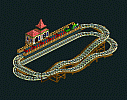 Miniature Railroad =
Miniature Railroad = ![]() Little Toot.
Little Toot.
 Monorail =
Monorail = ![]() Mondorail.
Mondorail.
 Observation Tower =
Observation Tower = ![]() Space Needle.
Space Needle.
 Whoa Belly =
Whoa Belly = ![]() Cape Canaveral.
Cape Canaveral.
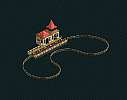 Cycle Railway =
Cycle Railway = ![]() CyCleTram.
CyCleTram.
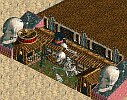 Ghost Train =
Ghost Train = ![]() Sally (from "How to build an effective Ghost Train").
Sally (from "How to build an effective Ghost Train").
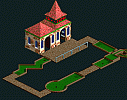 Miniature Golf =
Miniature Golf = ![]() Putt-Putt-Putt.
Putt-Putt-Putt.
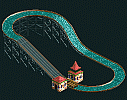 River Ride =
River Ride = ![]() Splashdown.
Splashdown.
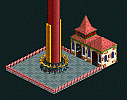 Roto-Drop =
Roto-Drop = ![]() Freefall.
Freefall.
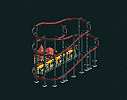 Suspended Monorail =
Suspended Monorail = ![]() Cradle Fall.
Cradle Fall.
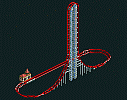 Air Powered Vertical Roller Coaster =
Air Powered Vertical Roller Coaster = ![]() Camelback.
Camelback.
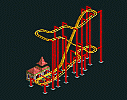 Inverted Wild Mouse Roller Coaster =
Inverted Wild Mouse Roller Coaster = ![]() Flader Maus.
Flader Maus.
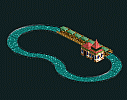 Raft Ride =
Raft Ride = ![]() Huck Finn.
Huck Finn.
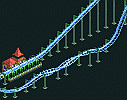 Suspended Looping Roller Coaster =
Suspended Looping Roller Coaster = ![]() Hang Time.
Hang Time.
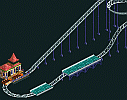 Water Coaster =
Water Coaster = ![]() Down the Drain.
Down the Drain.
To be accessible, all Track Files must be stored in the "Tracks" directory. Files ending with "TD4" are tracks. Files ending with "TP4" are pictures. Note that tracks do not have to have associated pictures, but a picture must have the exact same name as the track file to be associated with it.
The game was designed so that Fans could create and trade "Track" files amongst themselves. Only rides that form a complete circuit can be saved. There is also a limitation on the size of a ride that can be saved (so if you have a ride such as a "transport ride" that travels all over your park, you may not be able to save it). Unfortunatly, saved tracks can only be placed ON TOP of terrain. Therefore if you designed a ride that passes through terrain, you will have to first excavate land before placing the ride. Then after placing the ride you will have to demolish the part of the track that goes through the excavated terrain, raise the land appropriately, and then rebuild the missing track pieces through the newly raised land.
This ![]() "RCT Track Decoder" utility will ease the process of working with saved Track files. The utility creates a listing of each section of ride track, which you can save as a text file to refer to when rebuilding rides to penetrate terrain. It also has a handy "mirroring" feature which will create a mirror image TD4 file of the file you have opened.
"RCT Track Decoder" utility will ease the process of working with saved Track files. The utility creates a listing of each section of ride track, which you can save as a text file to refer to when rebuilding rides to penetrate terrain. It also has a handy "mirroring" feature which will create a mirror image TD4 file of the file you have opened.
Unfortunately, RCT does not provide a mechanism to create TP4 files for your own personally created TD4 Track files. This ![]() "MakeTP4" utility allows you to add pictures of your saved Track files. To use the utility, first make a "screenshot" of your saved ride (changing the zoom ratio and/or screen resolution will affect the amount of ride visible), ideally showing a clear view of the station. Next exit the game and launch the MakeTP4 utility. Select the screenshot (which saves as a PCX file into the same directory that contains your "rct.exe" file), and position the fixed sized cropping frame over the portion of the screenshot you wish to save as a "TP4" file. It is suggested that you include in the frame the station entrance and exit, so you can see exactly where you placed them (with the exception of the "Hedge Maze", when you save a Track file, the entrances and exits are not saved along with it). Finally, create a name for the saved "TP4" file that exactly matches the name of your saved Track file (so the "TP4" file will appear in the selection box associated with your saved Track file).
"MakeTP4" utility allows you to add pictures of your saved Track files. To use the utility, first make a "screenshot" of your saved ride (changing the zoom ratio and/or screen resolution will affect the amount of ride visible), ideally showing a clear view of the station. Next exit the game and launch the MakeTP4 utility. Select the screenshot (which saves as a PCX file into the same directory that contains your "rct.exe" file), and position the fixed sized cropping frame over the portion of the screenshot you wish to save as a "TP4" file. It is suggested that you include in the frame the station entrance and exit, so you can see exactly where you placed them (with the exception of the "Hedge Maze", when you save a Track file, the entrances and exits are not saved along with it). Finally, create a name for the saved "TP4" file that exactly matches the name of your saved Track file (so the "TP4" file will appear in the selection box associated with your saved Track file).
Most graphics viewing programs will not understand the TP4 image format. This ![]() "TP4toBMP" utility will create a conventional BMP format file of the TP4 file, which you can then view or manipulate with your favorite graphics program.
"TP4toBMP" utility will create a conventional BMP format file of the TP4 file, which you can then view or manipulate with your favorite graphics program.